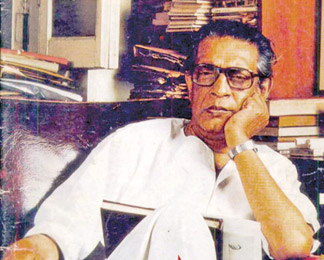|
Film Appreciation with K S Sivakumaran:
What is film appreciation or criticism?
 |
|
Satyajit
Ray |
Veterans in the cine industry
* Suresh Chabria
* P K Nair
* Sathish Bahadur
* Hugo Munsterberg
* Bela Belasz
* Seigfreid Kracaeur
* Sergi Eisenstein
* Andre Bazin
* Christian Metz
* Akira Kurasowa
* Satyajit Rai
* Lester James Peries
* Prof Wimal Dissanayake
The purpose of this column is to introduce world cinema of the past
decades and of present especially to young people who are interested in
the cinema as an art. The films selected are only those that have been
seen and enjoyed by this columnist. Such films include both from the
Occident and the Orient.
This columnist has seen these films mainly in International Film
Festivals held in India and while following a course in Film
Appreciation in 1990 at the prestigious Film and Television Training
Institute in Pune in the State of Maharashtra in India. Nearly 200 films
both as excerpts and full length films were shown to those students
attending the course. Apart from these whenever international films are
shown in Colombo from time to time I try to see as many films as
possible.
Since my approach to Literary Journalism is of a multi-disciplinary
nature I am naturally interested in literature that includes poetry,
fiction, drama and prose non-fiction especially literary and film
criticism and other performing arts. Cinema is both a visual medium and
also cinematic translation of prose written with an eye on aesthetic and
literary values as we have seen films continue to be adapted from great
novels and short stories, mythology and the like. I therefore like the
artistic cinema which is part of the media studies.
My first exposure at the film appreciation course was a revelation.
It was something that made me ‘un-learn’ what I knew as a film
journalist and learn afresh new ways of film appreciation through
learning about the social, aesthetic, technical and other related
subjects that constitute the total film. Suresh Chabria, P K Nair and
Sathish Bahadur were the main teachers at Pune. They were well known
film scholars in India. There were other visiting lecturers from other
parts of India specializing particular areas. Shyam Benegal was such a
celebrity. Sathish Bahadur explains that Film Appreciation is Film
criticism.
“The critic is also a spectator, but of special kind. What the critic
does has a special significance for the lay spectator, and for the film
maker, as also to the development of the art of the film.’ As the
lecturer described the critic has the crucial role as an interpreter and
teacher.’ The main professional task of the critic is to explain the
complexity of works of art, and to interpret art activity for the
education of the lay public.’
Readers would like to know the names of some of the film scholars.
They include Hugo Munsterberg, Bela Belasz, Seigfreid Kracaeur, Sergi
Eisenstein, Andre Bazin, Christian Metz, the Structuralists, the
Feminists, the post-Modernists, Griffith, Flaherty, Fellini, Eisenstein,
Chaplin, Jean Renoir, Orson Welles, Kurusowa, Satyajit Ray and many
others.
“The core task of Film Criticism is the analysis of the structure of
technique in making a film, and to use this analysis to identify the
value of structure of the meaning of that film. This is a method of film
study which provides a firm objective foundation to Film Criticism”,
says Satish Bahadur. This is a method of film study which provides a
firm objective foundation to Film Criticism.
Another point the lecturer pointed out is noteworthy. Literary
culture is not merely Literature. It is Literature plus Literary
Criticism.
It is Criticism which completes the communication process and makes
Literature a social entity. Likewise, Film Culture is not merely films:
It is Films plus Film Talking of technique in the Films, Bahadur has
this explanation:
“Film is also technique. The camera records fragments of moving
photographic pictures of various kinds: the mike recording system
records fragments of sounds of various kinds. The Editor arranges these
recoded fragments in a proper continuity. Earlier on, the script writer
had developed the ideas and stories into plans for filming by the
director. The actors had provided during shooting, along with several
other technicians, the visual and sound material to be recorded by the
machines. There is a great deal of specific techniques involved in the
work of each of the large number of jobs involved in film making.
But technique is not used for its own sake. It is used for creating a
meaning. A film leads to meaning. A film is about something.
In the final analysis film criticism is, and should be, a foundation
academic activity for all film studies. I am not sure whether the
courses in Mass Media in our country include Film Criticism per se as an
important aspect of studies.
Our own internationally known film director Sir Lester James Perris
is also a fine film critic in English with an elegant style.
Another distinguished academic well-versed in world literature
including Sinhala and Sanskrit Prof Wimal Dissanayake is one of the
authorities of Film as a medium of communication.
We should make use of their contributions.
[email protected]
|



